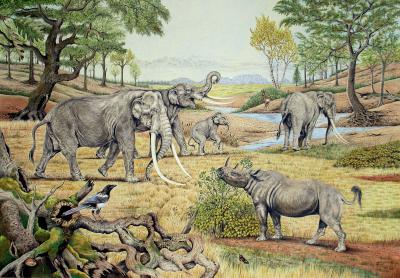Large mammals were the architects in prehistoric ecosystems

This is a reconstruction of a Last Interglacial temperate landscape (Germany) with typical Late Pleistocene European large herbivores such as the now extinct straight-tusked elephant (Elephas antiquus), an extinct rhinoceros (Stephanorhinus kirchbergensis), as well as the still common roe deer (Capreolus capreolus). Credit: Illustrator: Elke Gröning.
Researchers from Denmark demonstrate in a study that the large grazers and browsers of the past created a mosaic of varied landscapes consisting of closed and semi-closed forests and parkland. The study will be published on Monday 3 March 2014 in the renowned journal PNAS (Proceedings of the National Academy of Sciences of the United States of America).
Dung beetles recount the nature of the past
The biologists behind the new research findings synthesized decades of studies on fossil beetles, focusing on beetles associated with the dung of large animals in the past or with woodlands and trees. Their findings reveal that dung beetles were much more frequent in the previous interglacial period (from 132,000 to 110,000 years ago) compared with the early Holocene (the present interglacial period, before agriculture, from 10,000 to 5,000 years ago).
“One of the surprising results is that woodland beetles were much less dominant in the previous interglacial period than in the early Holocene, which shows that temperate ecosystems consisted not just of dense forest as often assumed, but rather a mosaic of forest and parkland,” says postdoctoral fellow Chris Sandom.
“Large animals in high numbers were an integral part of nature in prehistoric times. The composition of the beetles in the fossil sites tells us that the proportion and number of the wild large animals declined after the appearance of modern man. As a result of this, the countryside developed into predominantly dense forest that was first cleared when humans began to use the land for agriculture,” explains Professor Jens-Christian Svenning.
Bring back the large animals to Europe
If people want to restore self-managing varied landscapes, they can draw on the knowledge provided by the new study about the composition of natural ecosystems in the past.
“An important way to create more self-managing ecosystems with a high level of biodiversity is to make room for large herbivores in the European landscape – and possibly reintroduce animals such as wild cattle, bison and even elephants. They would create and maintain a varied vegetation in temperate ecosystems, and thereby ensure the basis for a high level of biodiversity,” says senior scientist Rasmus Ejrnæs.
The study received financial support from the 15 June Foundation and a grant from the European Research Council. To a large extent, it supports the idea that the rewilding-based approach to nature management should be incorporated to a far greater degree in nature policy in Europe –especially in the case of national parks and other large natural areas.
For more information, please contact
Professor Jens-Christian Svenning
Department of Bioscience
Aarhus University, Denmark
svenning@biology.au.dk
+45 2899 2304
Dr. Christopher Sandom
Currently:
Department of Zoology – Wildlife Conservation Research Unit
University of Oxford, UK
chris@wildbusiness.org
+44 (0)7979 858667
Senior Scientist Rasmus Ejrnæs
Department of Bioscience
Aarhus University, Denmark
rej@dmu.dk
+45 2020 5829
Media Contact
More Information:
http://www.au.dkAll latest news from the category: Earth Sciences
Earth Sciences (also referred to as Geosciences), which deals with basic issues surrounding our planet, plays a vital role in the area of energy and raw materials supply.
Earth Sciences comprises subjects such as geology, geography, geological informatics, paleontology, mineralogy, petrography, crystallography, geophysics, geodesy, glaciology, cartography, photogrammetry, meteorology and seismology, early-warning systems, earthquake research and polar research.
Newest articles

Superradiant atoms could push the boundaries of how precisely time can be measured
Superradiant atoms can help us measure time more precisely than ever. In a new study, researchers from the University of Copenhagen present a new method for measuring the time interval,…

Ion thermoelectric conversion devices for near room temperature
The electrode sheet of the thermoelectric device consists of ionic hydrogel, which is sandwiched between the electrodes to form, and the Prussian blue on the electrode undergoes a redox reaction…

Zap Energy achieves 37-million-degree temperatures in a compact device
New publication reports record electron temperatures for a small-scale, sheared-flow-stabilized Z-pinch fusion device. In the nine decades since humans first produced fusion reactions, only a few fusion technologies have demonstrated…





















